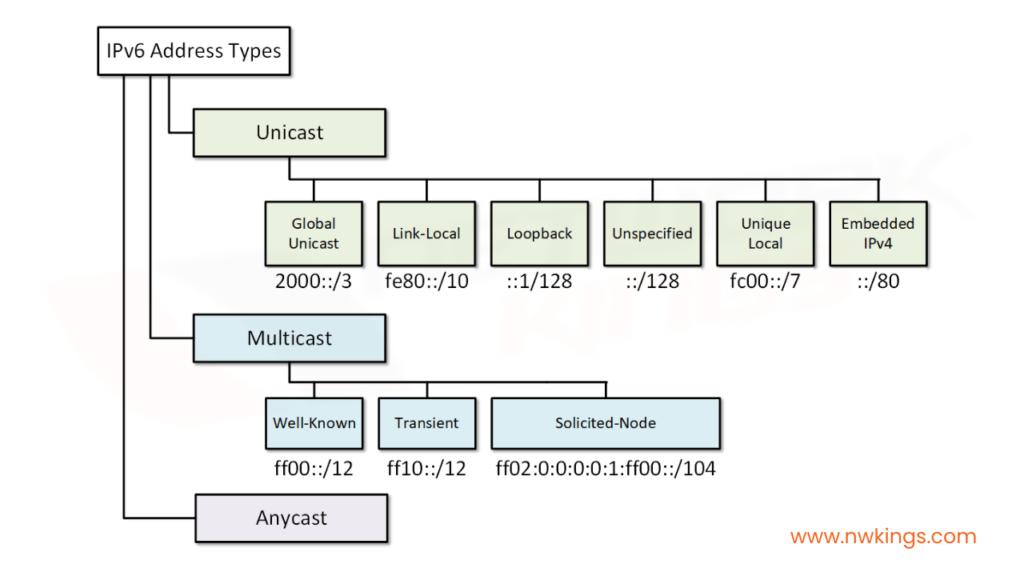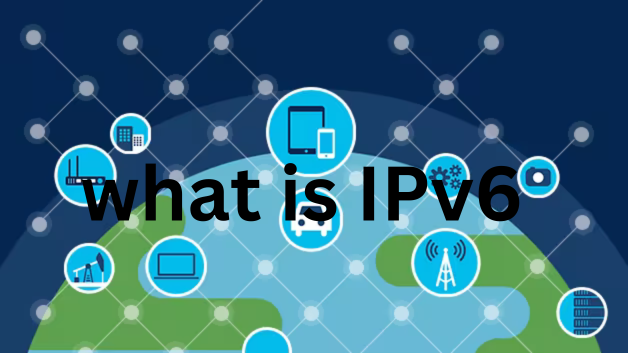IPv6, or Internet Protocol version 6, is the latest version of the Internet Protocol that is designed to replace its predecessor, IPv4. IPv6 address’s longer length, hexadecimal notation, and diverse address types contribute to the efficiency, scalability, and security of the internet infrastructure. However, the explosive growth of internet-connected devices has exhausted the pool of available IPv4 addresses, makes it mandatory to adopt IPv6.
IPv6 Advantages
Vast Address Space:
- The 128-bit address space of IPv6 provides an astronomically large number of unique addresses, addressing the limitations faced by IPv4 with its 32-bit address space.
End-to-End Connectivity:
- IPv6 promotes end-to-end connectivity by reducing the need for Network Address Translation (NAT). Each device can have a globally unique address, facilitating direct communication.
Enhanced Security:
In summary, IPv6 addresses are the cornerstone of the next-generation Internet Protocol, designed to accommodate the growing number of devices in our interconnected world.
IPv4 vs IPv6 Comparison
Address Length:
- IPv4: 32-bit addresses, limiting the available addresses to approximately 4.3 billion.
- IPv6: 128-bit addresses, providing an astronomical number of unique addresses (2^128).
Address Notation:
- IPv4: Dotted-decimal format (e.g., 192.168.1.1).
- IPv6: Hexadecimal notation separated by colons (e.g., 2001:0db8:85a3:0000:0000:8a2e:0370:7334).
Address Configuration:
- IPv4: Manual or DHCP (Dynamic Host Configuration Protocol) for address assignment.
- IPv6: Often configured automatically through Stateless Address Autoconfiguration (SLAAC) or DHCPv6.
NAT (Network Address Translation):
- IPv4 heavily relies on NAT to conserve addresses.
- IPv6 reduces the need for NAT due to its vast address space, promoting end-to-end connectivity.
IPv6 Address Types

IPv6 addresses are classified into various types, each serving specific purposes in the vast landscape of the internet. Let’s explore these address types along with examples.
Unicast Addresses:
- Global Unicast Address: Used for unique global addressing. Example: 2001:0db8:85a3:0000:0000:8a2e:0370:7334
- Link-Local Address: For communication within the same network segment. Example: fe80::1
Multicast Addresses:
- Multicast Address: Used for one-to-many communication. Example: ff02::1 (All-nodes multicast)
Anycast Addresses:
- Anycast Address: Assigned to multiple devices, and communication goes to the nearest one. Example: 2001:0db8:85a3::1
different types of IPv6 addresses with example
IPv6 addresses come in different types, serving various purposes in network communication. Here are some of the main types of IPv6 addresses along with examples:
Global Unicast Address:
- Purpose: Used for unique global addressing, allowing devices to communicate globally over the internet.
- Example: 2001:0db8:85a3:0000:0000:8a2e:0370:7334

Link-Local Address:
- Purpose: Used for communication within the same network segment. These addresses are automatically configured and are essential for local network communication.
- Example: fe80::1

Unique Local Address (ULA):
- Purpose: ULA is the same as a private IPv4 address and it is used for local addressing within an organization.
- Example: fc00::1
Multicast Address:
- Purpose: Used for one-to-many communication. Devices interested in a particular multicast group can subscribe to the corresponding multicast address.
- Example: ff02::1 (All-nodes multicast)
Anycast Address:
- Purpose: Assigned to multiple devices, but communication is routed to the nearest (topologically closest) one. Anycast is often used for load balancing and redundancy.
- Example: 2001:0db8::1
Loopback Address:
- Purpose: Used for communication within the same device. Similar to the IPv4 loopback address (127.0.0.1).
- Example: ::1
IPv4-mapped IPv6 Address:
- Purpose: Used for transitioning from IPv4 to IPv6. It can be used by IPv6-enabled devices to communicate with IPv4-only devices.
- Example: ::ffff:192.168.0.1
6to4 Address:
- Purpose: Enables communication between IPv6 networks over an IPv4 infrastructure.
- Example: 2002:c0a8:1::1
Types of Multicast IPv6 address
Multicast addresses in IPv6 have a specific format and are allocated for various purposes. Here are the main types of multicast IPv6 addresses:
All-Nodes Multicast Address:
- IPv6 Address:
ff02::1 - Description: This address is used to communicate with all nodes on the local link. It is akin to the IPv4 broadcast address but is more efficient and targeted.
All-Routers Multicast Address:
- IPv6 Address:
ff02::2 - Description: Intended for communication with all routers on the local link. Routers subscribe to this multicast group, allowing them to receive routing-related information.
MLDv2 Multicast Listeners Discovery:
- IPv6 Address:
ff02::16 - Description: Used for Multicast Listener Discovery (MLD) version 2. MLD is the IPv6 equivalent of Internet Group Management Protocol (IGMP) protocol in IPv4 and it is used by routers to discover multicast listeners on a link.
All-PIM-Routers Multicast Address:
- IPv6 Address:
ff02::d - Description: Used by Protocol Independent Multicast (PIM) routers on a link to discover each other. PIM is a routing protocol used for efficient multicast forwarding.
Solicited-Node Multicast Address:
- IPv6 Address:
ff02::1:ff00:0000/104(Note: The last 24 bits vary based on the unicast address) - Description: Used for efficient Neighbor Discovery Protocol (NDP) operations. When an IPv6 device joins a network, it uses the Solicited-Node Multicast Address to announce its presence to the routers on the local link.
IPv6 Multicast Addresses for OSPFv3:
- IPv6 Address:
ff02::5(All OSPFv3 routers)
- IPv6 Address:
ff02::6(All OSPFv3 designated routers)
- Description: Used by OSPFv3 (Open Shortest Path First version 3) routers to communicate. OSPFv3 is a routing protocol used for intra-domain routing.
More about IPv6 address format.
Related article : Introduction to Data Communication
